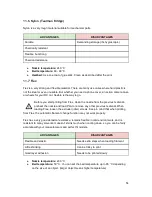
● Heatbed:
Make sure the surface is clean as described in
6.2.2 Flexible steel sheet
surface preparation
chapter. Some very soft flex materials can bond to the bed too
much and require use of glue on the bed as a separator to prevent PEI damage.
11.8 Composite materials
Composite materials (woodfill, copperfill, bronzefill, glow-in-the-dark, carbon or aramid
composites and many others) consist of a main plastic base and a second material in the
form of dust. These materials tend (except for wood composites) to be very abrasive,
therefore, a hardened nozzle is strongly suggested for long-term printing. A larger nozzle is
recommended while printing with wood composites (0.5 mm and up). Please use
corresponding print settings in Slic3r or PrusaControl as print parameters can be very
different depending on the plastic base.
The first step in polishing is sanding. It’s a good idea to start with a coarse grit size (80) and
slowly move up the grit table. After sanding, a big improvement in polish can be achieved
with steel wool or a brass brush. If you’re still not happy with the finish, you can try wet
sanding with a very fine grit (1500).
ADVANTAGES
DISADVANTAGES
Easy to print
Needs hardened nozzle
No warping
Great look after post-processing
● Nozzle temperature:
190 - 210 °C
● Bed temperature:
50 - 70 °C (bigger object -> higher temp.)
● Heatbed:
Make sure the surface is clean as described in
6.2.2 Flexible steel sheet
surface preparation
chapter.
11.9 ASA
Acrylonitrile-styrene-acryl (ASA) is a material with properties similar to ABS. Its main benefit
is an increased weather and UV resistance. Another advantage is overall dimensional
stability. To achieve a cast-like surface, acetone smoothing can be used…
ADVANTAGES
DISADVANTAGES
Heat and UV resistant
Bad smell
Soluble in acetone (easy post-processing)
High level of warping
Can be vapor smoothed
55
Summary of Contents for i3 MK2.5
Page 1: ......
Page 64: ...Pict 40 Nozzle change 64 ...
















































